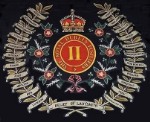Gibraltar on Bloomsday
The major difference between Molly's Gibraltar and the garrison town twenty years later, was the expansion of the naval facility which commenced in 1896. At the time that Tweedy and his daughter were on the Rock, the naval base lacked major repair facilities, could not accommodate large warships, and was primarily a coaling and victualling station. In 1895, Parliament, pursuant to the 1899 Naval Defence Act, approved a construction program to upgrade and expand the Gibraltar naval base and build one dry dock. The cost was estimated as £1.8 million. By then, the government was confident that Spain could not threaten the British Empire militarily and that a naval base at Gibraltar would not be imperiled by Spanish artillery. After construction began, the government progressively broadened the building program until it included three drydocks (one of double-length), extension of the civil mole, construction of a detached mole as a torpedo barrier, a small naval hospital, and filling in 45 acres of the harbor on which to construct workshops, storehouses, etc. Expansion of the naval base was mostly complete by 1906 after expenditure of nearly £6.0 million.
n/ Chris Grocott and Gareth Stockey, Gibraltar: A Modern History (Cardiff: Univ. of Wales Press, 2012, 46-48); John Black, "The Background to the Establishment of a Naval Dockyard at Gibraltar Following the Naval Defence Act of 1889," Transactions of the Naval Dockyards Society, no. 2 (December 2006).
There would be no further significant change to the topography of Gibraltar until the Second World War. In 1940, the Royal Engineers constructed a runway along the North Front on the site of the racecourse and in 1941, extended it into the bay on landfill.
Gibraltar, 1908
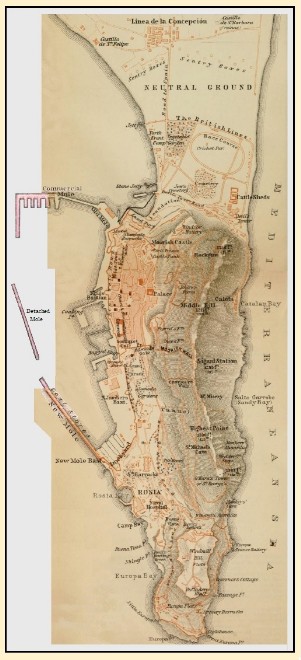
Wagner & Debes
Baedeker's Spain & Portugal, 3rd Ed. 1908
The above map is available for download from Major Tweedy's Neighborhood. It is in the file Baedeker_Gibraltar_1908.pdf (3.6 MB). Click on the above link and the file will open in a new browser window.
The map is from The Internet Archive's file for the above-noted Baedeker. It appears in the book on two pages and was edited somewhat to smooth-out the seam. Added from another map are the full extents of the civil and naval moles and the detached mole (not in the Wagner & Debes map). The editorial addition is clearly indicated.
Gibraltar as a Naval Base, 1902
"This naval base is of great strategic importance owing to the commanding position it occupies. Under the Naval Works Bill, both its strength and its usefulness are being lately increased. The existing mole is being considerably extended, and a new detached one is being built. A deep harbour of 260 acres is thus being formed, and 50 acres of the foreshore and water area are being reclaimed to make the new dockyard. A new coal store is also in process of erection. There are to be three new docks, one 850 feet, one 550 feet, and one 450 feet, and the arrangements arc such that merchant-ships will be able to load and unload alongside piers at the water port end of the new harbour.*
The necessity of increasing the usefulness of Gibraltar is very urgent, and is partly caused by the fact that our needs in the Mediterranean have outgrown the capacity of Malta. It may be permissible here to point out the large increase now being made in the accommodation of Gibraltar and Malta
Gibraltar is often described as commanding the entrance to the Mediterranean. This phrase is somewhat misleading, and does not mean that the guns mounted in the fort command the Straits of Gibraltar, so that no ship could pass without coming under fire. The real meaning is that Gibraltar is so situated that it is a safe base where a fleet may lie in harbour, and whence it may emerge to guard the Straits. In the same way, Malta cannot be said to 'command' the route to India, but to afford our fleet the opportunity of commanding it."
n/ C.H. Crofts, "Naval Bases and Coaling Stations" in The British Empire Series, Vol. 5 (London: Kegan Paul, Trench, Trubner, 1902), 195-96.
* The "water port end of the new harbour" is the civil harbor at the north end of the town.
The Naval Harbor
The construction of the dockyard and expansion of the naval base was Gibraltar's most significant economic event since the opening of the Suez Canal. The initial construction workforce of 2,000 expanded to 5,000 by 1898 and remained at that level until 1906. The workers, who were mostly Spanish nationals, were employees of British engineering firms engaged by the Admiralty. Employees of the Admiralty Works Department supervised the construction contracts. Several hundred workmen came from the UK, many of whom took up permanent residence in Gibraltar. After completion, the Gibraltar Dockyard became the colony's largest employer and remained so for several decades.
n/ Chris Grocott and Gareth Stockey, Gibraltar: A Modern History (Cardiff: Univ. of Wales Press, 2012, 58); John Black, "The Background to the Establishment of a Naval Dockyard at Gibraltar Following the Naval Defence Act of 1889," Transactions of the Naval Dockyards Society, no. 2 (December 2006); E.G. Archer, Gibraltar, Identity and Empire (New York: Routledge, 2006), 55-56.
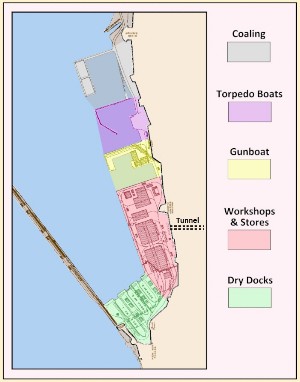
Prior to the First World War, dockyard total civilian employment was rarely fewer than 2,000 and usually many more. In 1980, long after the sun had set on the British Empire, the Gibraltar Dockyard still employed 1,340 civilians. The British government transferred the dockyard to a private firm in 1984.
n/ 65 Parl. Deb. (H.C. 5th ser.) 739-41.
The base's wartime role was to provide coal and munitions for Royal Navy vessels. Coal was stored at the naval coal yard and munitions in the naval magazine buried in the Rock. The naval magazine was connected by tunnel to the Naval Ordnance stores area of the harbor.
n/ A.B. Tulloch, "Naval Coaling Ports and Their Garrisons, " RUSI Journal 49 (January 1905): 141-58.
Torpedo Boat Camber

Workshops & Stores
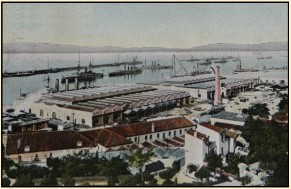
Dry Dock No. 1
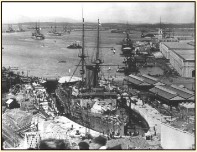
The Naval Establishment
Commanded by a rear-admiral who also served as superintendent of the dockyard. Combat vessels assigned to the Gibraltar Station had a total complement of about 280 men, all ranks. Land-based uniformed personnel of the Royal Navy and Royal Marines totaled about 210 men.
Most of the shore establishments were staffed by personnel of the Admiralty's civil departments (Naval Ordnance, Victualling, Works, Transport) and were civilians. Note that of the Dockyard's twenty-two professionals and senior staffers, only two were Royal Navy officers (a commander and a lieutenant). There were about 120 management, professional, and technical navy civilians in the shore establishments plus about 100 civilian crew members of the harbor vessels. Rank-and-file employees, nearly 2,000, were hired locally and were mostly Spanish nationals. This group was composed of coal heavers, laborers, carters, porters, and tradesmen. Local employees of the Victualling Yard (57), Naval Hospital (13) and Dockyard Police (33) were all Gibraltarians.
Warships
HMS Plover - A 755 ton 1st Class gunboat armed with six 4" guns; complement of 76.
11 Torpedo Boats - All 85 to 100 tons and armed with three 18" torpedo tubes; complement of 18.
HMS Plover - A 755 ton 1st Class gunboat armed with six 4" guns; complement of 76.
11 Torpedo Boats - All 85 to 100 tons and armed with three 18" torpedo tubes; complement of 18.
Harbor Vessels
4 harbor tugs, 2 water replenishment tankers, 1 oiler. All with civilian crews.
4 harbor tugs, 2 water replenishment tankers, 1 oiler. All with civilian crews.
Receiving Ships (not sea-going)
HMS Cormorant - 1,150 ton screw sloop, Naval Station and Dockyard headquarters.
HMS Hercules - 9,300 ton 3rd Class Battleship, housed civilian employees.
HMS Rapid - 1,420 ton 3rd Class Cruiser, housed civilian employees.
HMS Cormorant - 1,150 ton screw sloop, Naval Station and Dockyard headquarters.
HMS Hercules - 9,300 ton 3rd Class Battleship, housed civilian employees.
HMS Rapid - 1,420 ton 3rd Class Cruiser, housed civilian employees.
Shore Installations
HM Dockyard Gibraltar
Coaling Station
Victualing Yard at Rosia Bay
Naval Hospital
Naval Base
HM Dockyard Gibraltar
Coaling Station
Victualing Yard at Rosia Bay
Naval Hospital
Naval Base
The Gibraltar of the 1880s described in Ulysses had a much smaller Royal Navy contingent. The station's gunboat complement was 60 and there were about 25 shore-based personnel. There were three harbor tugs and one receiving ship (used as an army barracks).
n/ Sources: Lawrie Phillips, Pembroke Dockyard and the Old Navy (Cheltenham, UK: The History Press, 2014); Monthly Navy List, January 1907; Norman Friedman, British Destroyers from the Earliest Days (Barnsley, UK: Pen & Sword, 2009); Admiralty, Navy Estimates for 1906-07, 1906, H.C. Accounts & Papers, No. 28.
From the website of the Gibraltar Garrison Library. Click on the link and the image will open in a new browser window. Right-click on the image to download this 343 kb .jpg file. Click on the icon to the right for the library's home page.
The Civil Harbor
As can be seen in the graphic below, the British government significantly increased the mooring capacity of the civil harbor after Molly saw old Sprague on the docks dressed in mourning as she and her father departed Gibraltar for Dublin.
n/ Ulysses (Gabler) 18:683-84.
Port of Gibraltar, 1904
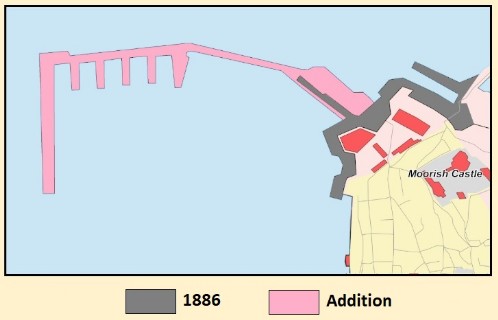
Expansion of the civil harbor began after vessel traffic had declined from its peak in 1889 at 12,515,850 tons, entered and cleared. As shown below, harbor traffic, measured in tonnage, in 1904 was about the same as in 1886, the year Molly left Gibraltar. Beginning in 1904, annual harbor traffic increased progressively and reached its 1889 level in 1913.

Sources: Board of Trade, Statistical Abstract for the several Colonial and Other Possessions of the United Kingdom - From 1864 to 1878, 1880 [C. 2520], From 1878 to 1892, 1893 [C. 7144], From 1892 to 1906, 1907 [Cd. 3707].
In its maritime trade, Gibraltar was essentially a coaling station, and coal was overwhelmingly the principal commodity that entered and left the port. Gibraltar refueled the warships of the Royal Navy and merchant vessels that flew all flags. Prior to the extension of the civil mole, coal for merchant vessels was stored in hulks anchored in the bay. Coal was offloaded from coal freighters onto the hulks where it awaited offloading as fuel for merchant vessels. The civil mole extension had storage yards for 30,000 tons of coal plus moorings for vessels. The coal hulks would soon be gone.
n/ A.B. Tulloch, "Naval Coaling Ports and Their Garrisons, " Royal United Services Institute Journal 49 (January 1905): 141-58.
The movement of coal was handled by coalheavers who were employed by both local coaling firms and the Royal Navy. Most coalheavers were Spanish nationals who entered the colony on day-tickets. See Neville Chipulina's article on coalheavers at his website, The People of Gibraltar. Click on the link and the article will appear in a new browser window.
Gibraltar: Linchpin of Empire?
Shortly after Britain took possession of Gibraltar, many in government questioned its importance regarding imperial defense. As noted at the top of this page, even in 1904 the Strait was not within gun range of the fortress. Henry M. Field, in his 1889 book on Gibraltar, wrote "... that a fleet of ironclads, hugging the African coast, would be quite safe from English fire." Field, a Massachusetts clergyman, concluded that the Gibraltar fortress was not worth its immense cost of upkeep.
In the early eighteenth century, among British leaders who saw little military value in Gibraltar were General James Stanhope (Whig MP and Cabinet Member) and Charles Townshend (Whig MP). Gibson believes Joyce named Major and Marion Tweedy's Gibraltar friends "Stanhope" as a swipe at British imperialism. He claims that Stanhope (along with Pitt the elder, Townshend, and Shelbourne) "kept on trying to give [Gibraltar] back to Spain" and that "Stanhope was the surname historically most closely associated with the idea of surrendering Gibraltar to the Spanish." This isn't completely correct as the named personages did not want to abandon Gibraltar but trade it for a Spanish possession. Stanhope sought to swap Gibraltar for Florida and Cuba, while Townshend was satisfied with just Florida. A Whig faction introduced in Commons a bill to authorize the Crown to dispose of Gibraltar "for the advantage of his subjects." The sponsoring MPs did not pursue the matter as it caused a public uproar in opposition.
In 1857, William Pitt, Secretary of State for the Southern Department, proposed to exchange Gibraltar for the Mediterranean island of Minora, but public opposition ended the matter. Twenty-five years later, Captain Warren of the Royal Navy argued in a monograph that "A fortified, secure harbour, and coal depot in the Straits is a necessity to England, and that the Bay of Gibraltar is not at present."
n/ Henry M. Field, Gibraltar (London: Chapman & Hall, 1889), 121-27; Andrew Gibson, Joyce's Revenge (New York: Oxford Univ. Press, 2002), 253, 264; Frederick Sayer, The History of Gibraltar and of Its Political Relation to Events in Europe (London: Chapman & Hall, 1865), 151, 157-64, 246-49; Fred P. Warren, Gibraltar: Is it Worth Holding? (London: Stanford, 1882).Note that most Joycean scholars attribute the name "Hester Stanhope" to the well-known, eccentric, English aristocrat who in 1810, at age 34, left her homes in Wales and London and eventually settled in what is now Lebanon. Lady Stanhope was a great-granddaughter of General James Stanhope (1st Earl Stanhope). When she left home, she intended only to spend a year or two in Sicily. Naturally, on her way there she stayed briefly in Gibraltar and was entertained by Governor-General Oakes. In Lebanon, her wealth led to political power in that corner of the Ottoman Empire that almost amounted to sovereignty. Her fiefdom was known locally as "Joun of Lady Stanhope." Joun was the village near her hilltop residence, an abandoned monastery, where she lived with an English physician, an English lady's maid, an English housekeeper, a Levantine secretary, and "a small number" of servants from the countryside. Catherine Cleveland, The Life and Letters of Lady Hester Stanhope (London: Murray, 1914).
Napoleon believed that only the UK's enemies benefited from a British-held Gibraltar! In 1816, British Admiral George Cockburn visited Napoleon then in exile on the Atlantic island of St. Helena. The admiral asked Napoleon why he never attacked Gibraltar. The former Empereur replied:
[The situation of Gibraltar] "... served us quite well. This place is of no use to you; it neither defends nor intercepts anything; it is only an object of national self-love which costs England very dear, and singularly wounds the Spanish nation. We would have been very stupid to destroy such a combination."
n/ In French at Emmanuel Auguste Dieudonne (Comte de las Cases), Le Memorial de Sainte-Helene (Paris: Garnier, [1823]), 391-92.
Population, The 1901 and 1911 Census

Near the end of Molly's time in Gibraltar, about 5% of aliens living in Gibraltar had permanent residency status. In 1885, Governor Adye's Aliens Order in Council terminated issuance of permanent residency permits and by 1901, only fourteen resident aliens had permanent status. Under the order, even British-born women with alien husbands could only have temporary status as such women, upon marriage, lost citizenship rights. Note that under the British Naturalization Act of 1870, alien women who married British subjects acquired the nationality of their husbands and accordingly, as British subjects, had Gibraltar residency rights. Spanish nationals accounted for 85% to 90% of the alien population. The decline in alien residents from 1901 to 1911 was due to the completion of harbor construction.
The decline in the military population from 1901 resulted from a War Office decision to reduce the usual infantry garrison from four battalions to three.
The 1911 census was the first that enumerated literacy. Among persons aged five and older, 75% of the British subjects and 51% of the alien residents claimed to both read and write. In the 1901 Census of Ireland, the last to enumerate literacy with an age cutoff of five, 79% of the population could both read and write.
During the first decade of the twentieth century, about 21% of the approximately 6,000 employed, resident males held unskilled jobs. In 1901, one-third of unskilled laborers were coalheavers; in 1911 about one-seventh. Clearly most of the unskilled work in Gibraltar was performed by non-resident Spanish workers. About 6% of employed males were domestic servants; somewhat over one-half of employed female residents were domestics. In 1901, 589 residents were of independent means (2.8% of population) and 29 were pensioners; 619 (3.1%) and 32 in 1911. About three-fourths of those living on their own means were female. From 1901 to 1911, the total number of employed residents fell from 9,213 to 8,249.
To view the census abstracts for Gibraltar, click here. The link is to a page on the website of the Gibraltar National Archives which will open in a new browser window.
Residency Permits for British Subjects
Since the early 19th Century, Gibraltar authorities limited the number of aliens allowed to reside in the colony. By the beginning of the 20th Century, no alien could obtain a permanent residency permit and those who planned to remain in Gibraltar for more than 20 days required a temporary residency permit. British subjects did not need permission to reside in Gibraltar.
On June 29, 1900, the Privy Council approved the Governor's "Aliens Order Extension, 1900" which made the residency ordinances applicable to British subjects, including those who resided, or were born, in the United Kingdom.
"The Aliens Order in Council, 1885, save as in this Order or any Rules for the time being in force thereunder expressly provided, shall apply to a British subject, who is neither a native of Gibraltar nor employed in Gibraltar in His Majesty's Service, nor the wife or child of either of the foregoing persons, in the same manner as if he or she were an alien."
Section on Gibraltar from Karl Baedeker, Spain and Portugal Handbook for Travelers (New York: Scribner's, 1908), 442-49. The section is in a pdf file on Major Tweedy's Neighborhood. Click on the above link to download the file, BaedekerText_1908.pdf (0.7 MB). The file will open in a new browser window.
[ You are at www.majortweedy.com>Molly's Gibraltar>Gibraltar on Bloomsday ]
